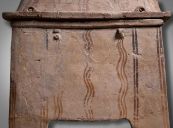A trip across the sea...
The decorations of Minoan clay wares are very recognizable; they are unnaturalistic, abstract and full of organic symbolism, derived mainly from floral and marine spheres. Larnakes are especially lavishly decorated with scenes relating to funerary customs, and as such they comprise the largest source of pictorial art from Late Minoan III Greece (ca. 1400-1050 BCE).
Larnakes often depict sacrificial images, apotropaic symbols, goddesses, mourners, seascapes or visualisations of the idealized Afterworld, a land located beyond the Aegean sea. Even though our larnax is rather unique in its modesty, it still includes the main elements regarding Minoan funerary culture: the sea and flowers.
As Crete is a relatively isolated island in the middle of the Aegean sea, it is understandable that the Minoans imagined their Afterworld as a distant land across the sea, beyond the horizon. Because larnakes were considered the vessel in which the dead undertook their last journey to the hereafter, seascapes dominate their imagery. They can range from octopuses, fish, dolphins or argonauts, to simple waves. This larnax is decorated with the latter; the sea is represented by the wavy lines on the front and back of the coffin.

](https://micrio.thingsthattalk.net/gRjdf/views/max/192x128.jpg)
](https://micrio.thingsthattalk.net/lKMcG/views/max/192x128.jpg)